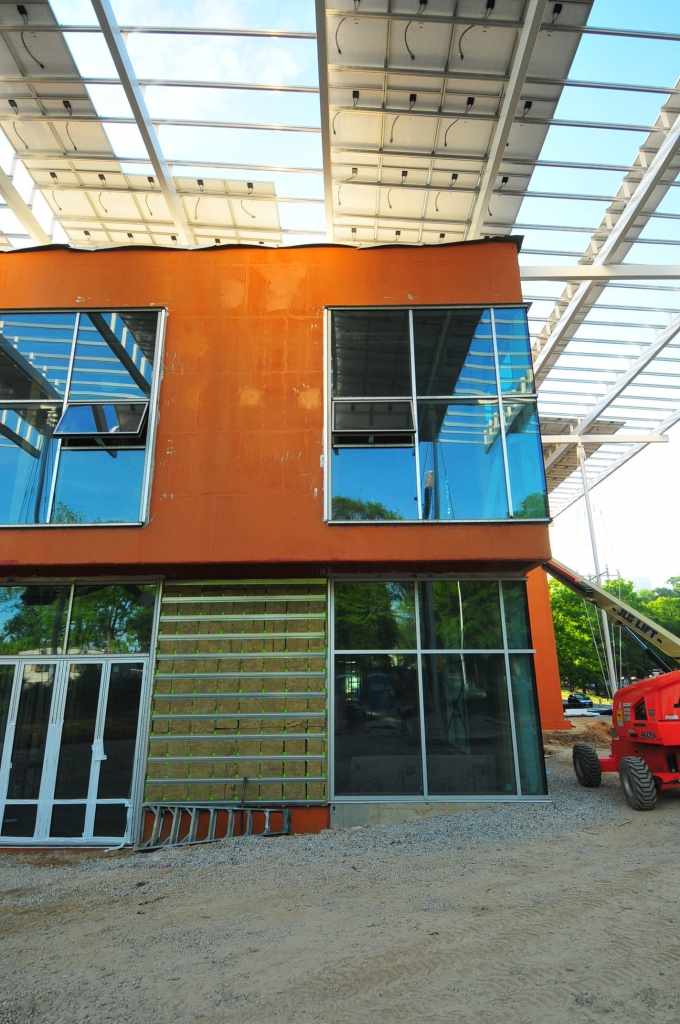Harvesting on-site renewable energy
“The intent of the Energy Petal is to signal a new age of design, wherein the built environment relies solely on renewable forms of energy and operates year-round in a safe, pollution-free manner. In addition, it aims to prioritize reductions and optimization before technological solutions are applied to eliminate wasteful spending—of energy, resources, and dollars.” International Living Future Institute
The Energy Petal requires net positive energy, which means at least one hundred and five percent of the project’s energy needs must be supplied by on-site renewable energy on a net annual basis, without the use of on-site combustion. As with other natural resources, The Kendeda Building must balance the energy it uses with the energy it is able to harness. Consideration is first given to climate-appropriate passive design, then energy conservation measures, which reduce the size of renewable energy system needed, and, finally, to on-site renewable energy.
The Kendeda Building has two 64-person classrooms, two 24-person class labs, two 16-person class labs, a 16-person conference room, makerspace, 176-person auditorium, rooftop apiary and pollinator garden, and an office space for co-located programs. Based upon this programming, it has a projected energy use intensity (EUI) of 30 kBTU/SF/YR, which is 72 percent more efficient than an average building of the same size and occupancy.
Passive Design
Passive design is a technique that designers use at the initial planning stages of a project to leverage the natural climate, solar, and energy characteristics of a building and its surroundings to lower energy demands. For The Kendeda Building, designers prioritized the following variables to enhance the building’s ability to operate passively in Atlanta’s climate, especially to reduce cooling needs and the associated energy needs.
Designing an Efficient Building Envelope
The performance of the building envelope is critical both to the energy efficiency of the building and to the comfort level of the occupants. This includes continuous insulation at walls and under slabs and triple pane window glazing which helps to reduce building loads in winter and summer.
Shading to Reduce Solar Heat
The building's photovoltaic (PV) canopy multitasks by harnassing energy, collecting rainwater, and providing shade for the south and west façades, the elevations that receive the most solar gain. The shaded areas help create a micro-climate that eases the transition between inside and outside of the building.
In addition, exterior operable and non-operable venetian blinds on the building’s west façade help manage the cooling requirements due to summer sunshine. Shades aid in solar control and daylighting optimization for occupants. Strategically placed trees also help control unwanted solar gains.
Using Daylight to Reduce Energy Demands
Daylighting design plays a large role in reducing system energy needs, improving occupant health and wellbeing, and connecting occupants to the outdoor environment. In addition, skylights and clerestory windows were designed in the large atrium space for continuous daylighting in the building.
Reducing Air Infiltration
Vestibules, air curtains at entries, and an efficient building envelope help prevent the movement of hot air and humidity into the building. Operable windows – with a system override – throughout the building is mechanically operated when outdoor temperature, humidity, and pollen count are within an acceptable range to maintain system balance.
Providing Thermal Comfort
The Kendeda Building is designed to operate within a broader range of thermal comfort than a typical building. By carefully considering air and radiant temperature, humidity, and air speed, as well as occupant activity and clothing, the building operates at higher air temperatures in the summer without sacrificing occupant comfort. This reduces energy use and the size of the mechanical system that needs to be installed.
Energy Conservation Measures
Every variable of the building’s passive design is evaluated using the energy models. The models also predict how much energy savings can be achieved by implementing additional energy conservation measures. Ultimately, the energy model determines how many photovoltaics are required to offset the energy needs of the building. Additional energy-related factors such as operating hours, thermostat set points, and plug loads become enormously important when all power must be generated onsite.
The energy demands for The Kendeda Building are higher than other certified Living Buildings. The building is open 15 hours a day Monday-Friday for 51 weeks of the year. It hosts regularly-scheduled classes, labs, tours, and evening and weekend events. The extended hours and activities result in high energy usage demands. Anticipated high pedestrian traffic increases demand on everything from toilets to lights as well as the heating, ventilating, and air conditioning (HVAC) system – all driving demand on the PV array and the net positive water supply.
Cooling and Heating the Building with Efficient Mechanical Systems
Equipped with additional condensation sensors and temperature reset strategies to mitigate moist floors, a radiant heating and cooling system in the flooring is used throughout most of the building. In addition, an energy efficient dedicated outdoor air system (DOAS) provides heated or cooled (and dehumidified) ventilation air to a majority of the building’s spaces. To accommodate large audiences, the auditorium has a dedicated variable air volume HVAC. Ceiling fans are used throughout the atrium space and classrooms for air circulation.
Borrowing Water and Energy from the Campus Central Loop
The building’s mechanical system, including the radiant flooring system and the DOAS uses chilled water from the campus’ central system. When the building needs to provide cooling, the mechanical system draws chilled water (45 ̊ F) directly from the campus loop. The incoming humid air flows across the coils and condensate is produced, collected, and used for irrigation. As a result, the incoming air is dehumidified and temperature is further reduced before entering the building.
When the building needs to provide heating, the mechanical system uses the campus heat recovery chiller to provide heat. Both the water and energy (in the form of heat) borrowed from the central plant is metered and taken into account in the annual net positive calculations.
Refrigerants
The Kendeda Building does not directly use refrigerants in the DOAS because it is connected to campus chilled water. Note that the campus chilled water is produced using R134a.
The Kendeda Building does have refrigerant in the building heat pumps, which is R410a. These run in the winter to create building hot water, and the byproduct of that process is chilled water that is exported back to the campus chilled water loop – similar to how the building exports excess power from the PV system.
Harvesting Energy from the Sun
The building's 330 kW (DC) solar canopy is comprised of 917 PV panels and is generates over 400,000 kWh per year that directly serves the building’s energy demands including lighting, HVAC system, water system, and plug loads. A lithium ion battery is charged exclusively by the PV array and serves as the emergency back-up system for the building in the case of power outages. The sizing of the PV array included the building’s system energy demands, a safety factor of 10 percent, plus the 5 percent net positive factor that is required for Living Building Challenge certification.
When the PV array is not producing adequate amounts of energy, the building loads run off of electricity from the grid. When the PV array is producing more electricity for the building than needed, the building supplies electricity back to the grid. The PV array has also been sized to account for energy used from the campus chilled water connection. Water from the campus connection is metered, energy is calculated, and an energy offset is supplied to the grid in order to meet the annual net positive requirements. By harnessing more energy than the building consumes, the systems create a net positive energy facility on an annual basis.

Energy Dashboard
Our partners at Georgia Tech Aerospace Systems Design Laboratory manage the Kendeda Building energy dashboard.
Harvesting Energy from the Sun

Approximately 917 solar panels are being installed on the roof of The Kendeda Building and are expected to generate over 455,000 kWh per year.
Changes From LBC 3.1 to 4.0
LBC 3.1 had one Energy Imperative: Net Positive Energy. LBC 4.0 has two:
- Imperative 07: Energy + Carbon Reduction
- Imperative 06: Net Positive Energy
Imperative 07: Energy + Carbon Reduction
While several requirements in this Imperative were included in other Imperatives under LBC 3.1, for the most part this is a new Imperative under LBC 4.0. Projects are required to achieve high levels of energy efficiency and reduce embodied carbon in both primary materials and interior materials.
Onsite renewable energy is not required in this Imperative, However, projects must be ready to install renewable energy systems in the future. The requirements related to metering and combustion limits moved from LBC Imperative 06, Net Positive Energy in LBC 3.1 to this Imperative in LBC 4.0.
Imperative 06: Net Positive Energy
ILFI made two changes to this Imperative to more comprehensively address embodied carbon and resiliency concerns. The embodied carbon offset requirements from Imperative 11,
Embodied Carbon Footprint in LBC 3.1 has been incorporated into the requirements of this Imperative with minor modifications. Additional compliance pathways for meeting the resiliency requirements have also been added.
To meet its energy needs, a project with physical and/or utility policy restraints may scale jump to a nearby building that is not constrained so long are certain parameters are met. An interesting scale jumping outcome can be a project investing in the development of new renewable energy systems on local affordable housing properties.
This approach was taken by PAE for its Living Building in Portland, Oregon. The constraints of the Historical District limited the space available to reach 105% of the building's annual energy needs. PAE scale jumped by donated 60% of the PV panels to a local affordable housing development. The PAE Living Building retains the Renewable Energy Credits, while the housing development gets a boost of on-site energy at no cost.
Campus Solar
Campus projects may scale jump to a nearby area or building so long as the following parameters are met:
- Live within the project’s solar income and protect other projects’ solar potential.
- Install renewables with additionality, or connect to a campus grid if the renewable energy allocated to the project is not already in use by, or dedicated to, any other part of the campus.
- Sub-meter and track energy to demonstrate that the energy required for the project is covered by the system, and attributed to only the LBC project.
- Provide information about the off-site infrastructure and production in their on-site education materials.
Energy resources may not be traded or doubled-counted.